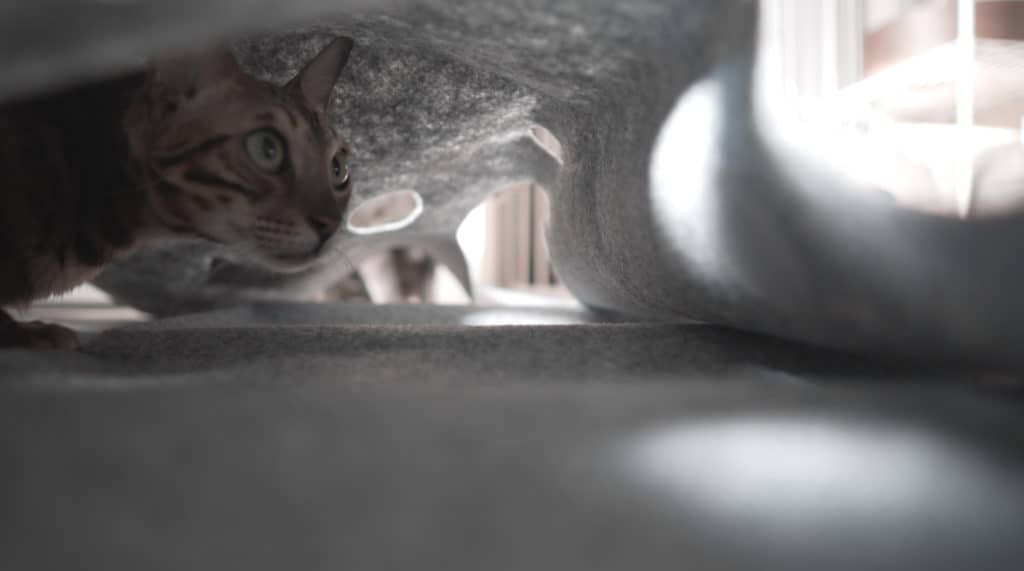Like with any relationship in life, there are going to be times of turbulence and anxiety. As such, there are going to be times in which something happens that might cause your cat a fright – possibly because of you and possibly because of something else entirely. With cats, it’s difficult to know.
Before you go and tell me your cat hates you, remember cats are cats. They don’t grasp the concept of hate, but they frequently have the spectrum of feelings through confidence, comfort, fear, and stress.

Therefore, when your cat is afraid, it’s a good idea to take a step back and see it from all directions to pinpoint the real reason. When interacting with a frightened cat, keep your actions slow and subtle is the best way to mend these types of situations – other times, not doing anything at all is the best course of action. Sometimes in our haste to fix the situation, it can inadvertently make it worse, so knowing when to attend to your cat is a good skill to have.
Check Your Cat’s Body Language
First, it’s a good idea to check their body language to see if it’s fear or something worse. In some cases, someone’s cat feeling “fear” might be just anxious and skittish which is fairly easy to address. However, for the more extreme cases – it could mean cat owners need to take a more investigative approach to get to the truth of the matter.
Below is a body language chart to check to see which side of the fear spectrum your cat might be on.
| Extreme Fear & Fight Aggression | Moderate Fear | Mild Signs | Anxious & Skittish |
| -Dilated pupils -Flatted Ears -Hissing -Growling -Swatting -Arched back | -Hissing -Escaping -Turning back to keep an eye on the focus -Tail tight | -Turning head away -Tail close to the body -Escaping | -Eyes dilated -Head low and tails close to the body -Quick to disperse |
For cats, fear and illness can often be two sides of the same coin. Why you might ask? If it is ill, the cat doesn’t know that the pain is coming from inside its body but could associate it with something external. Therefore, if none of the below methods work – it might be time to get a check-up.
Reasons Why Your Cat Might Be Scared
Some of the most common occurrences that might cause your cat to be frightened are:
- An accident – whether it’s stepping on their tail or closing a door on them
- Loud or surprising noises
- Adjusting to a drastic change – this is quite interesting as it recently happened to me. I was beginning to move out of my apartment and all of the furniture was taken out of the room (excluding the cat furniture) but even though it was the same room but without all the furniture, the cats were anxious and quite nervous.
- Strangers, strange animals, or other cats – sometimes your cat might smell, see, or even interact with something that you didn’t notice throughout the day.
- Been away from you for a long time – sometimes cats can escape because of whatever reason and when you retrieve them, it might have been a while since they had human contact. Therefore, cat owners might have to start gaining its trust once more.
What if your cat is scared of you? A sign that your cat has associated the negative event towards you is if it keeps its eyes on you. Wherever it moves it always checks back and looks at you to see where you are.
Again, it might not be your fault, but there are times when the butler gets caught in between the crossfire of something because of something beyond your control.
Reduce Interactions & Attention To The Cat
In cat-to-human interactions, less is more sometimes. A typical situation might go like this:
– the owner steps on the cat’s tail hard and the cat scurries off to curse at its human
– in a fit of frantic apologies and guilt, the human quickly approaches the cat yelling apologies and approaches while at the same time locking eyes with the frightened cat
– the cat freaks out some more and hisses
With another human, it makes sense to go through the fit but with a cat, it exacerbates the issue. When events like this happen – just do nothing.
Doing nothing signals to the cat that it’s no big deal, and you have no plan to eat them. Just go on as nothing has happened. For cats, creatures that have not changed instinctually for millions of years – for something to give that much attention, is usually something that wants to eat them.
Usually, after a fright or an accident, waiting 20-30 minutes is a good start. Just be aware of where they are and if they start moving around after a bit of time. It’s quite typical for cats to get out of their funk before 30 minutes is up and then go about their day normally. However, if they’re still scared and hiding after that – then you might want to check them.

My Bengal cat is an example of this, he’s a bit shy by nature so with anything towering above him – he instinctively gets out of the way. Even if it’s as simple as me carrying a grocery bag above him, he’ll tend to be a bit anxious and sprint out of the way until I finish organizing. So whenever he’s in that mood – I found it best to let him get his own bearings by himself.
Low and Slow Method for Interacting With a Scared Cat
Cats will sometimes vary in terms of their adjustment times if they’ve just moved somewhere new. Check out my more in-depth guide on cat adjustment times based on age and other factors here: How Long Does It Take a Cat to Adjust to New Home.
If you do need to interact with a cat that’s been frightened or had an accident and need to check if he’s okay. Then keep your movements subtle and your body as close to the ground as possible.
Sitting down and scooting slowly over to a cat is a good way to approach. Afterward, reach out your hand lower than their head and see if they allow you to teach their body.
If they do, then you can talk calmly to try to comfort the cat and gently stroke him/her. If the cat then starts to move around – it should be alright. However, if anytime during the inspection that he suddenly reacts and hisses, it’s likely that they’re hurt somewhere and a trip to the vet might be necessary.
Reduce and Block Off Cat Hiding Spots to Let Cats Push Their Comfort Zones
This is more for cats that have just moved to a new home, experience a drastic environment change, or just a super-scaredy-cat. Cats that are afraid of everything and dart towards the closest dark corner they can find – maybe under a bed or in the corner of a drawer/cabinet. They might stay for hours and it’s even hard to get to them, let alone interact with them.

This is a fairly underrated method because it seems a bit mean. I felt it was a bit mean in the past too – why would you want to block off a place that they feel safe? However, it realized that it doesn’t let them grow into their environment in hiding like that.
So what do we do? We have to block off all the places underneath furniture that we can find. Usually, it’s the bed or the cabinet. In my apartment – I actually only have a mattress, no bed frame. You don’t have to go as hardcore like me, blocking off the underneath of the bed is as easy as taking some large boxes and shoving them in.
It’s okay to leave their carrier or a cat-cave or something similar for them to feel secure in but for a cat to be under something for hours – is not good for their development because it doesn’t let them push their comfort zones. Like humans, cats have comfort zones, and the more they push out from that, the more confident they feel in their environment.
Recommended Tools to Relax a Shy or Afraid Cat
For effective methods to make your cat like and trust you again, read my article here!
If there’s one thing that a lot of cat owners have in their back pocket during these types of situations – it’s Feliway. It helps cats calm down and feel secure with their environment again.
 Feliway 30 Day Starter Kit
Feliway 30 Day Starter Kit
Feliway is a synthetic copy of the feline facial pheromone, used by cats to mark their territory as safe and secure. By mimicking the cat’s natural facial pheromones, Feliway creates a state of familiarity and security in the cat's local environment. As a result, Feliway can be used to help comfort and reassure cats while they cope with a challenging situation and help prevent or reduce the stress caused by a change in their environment.
